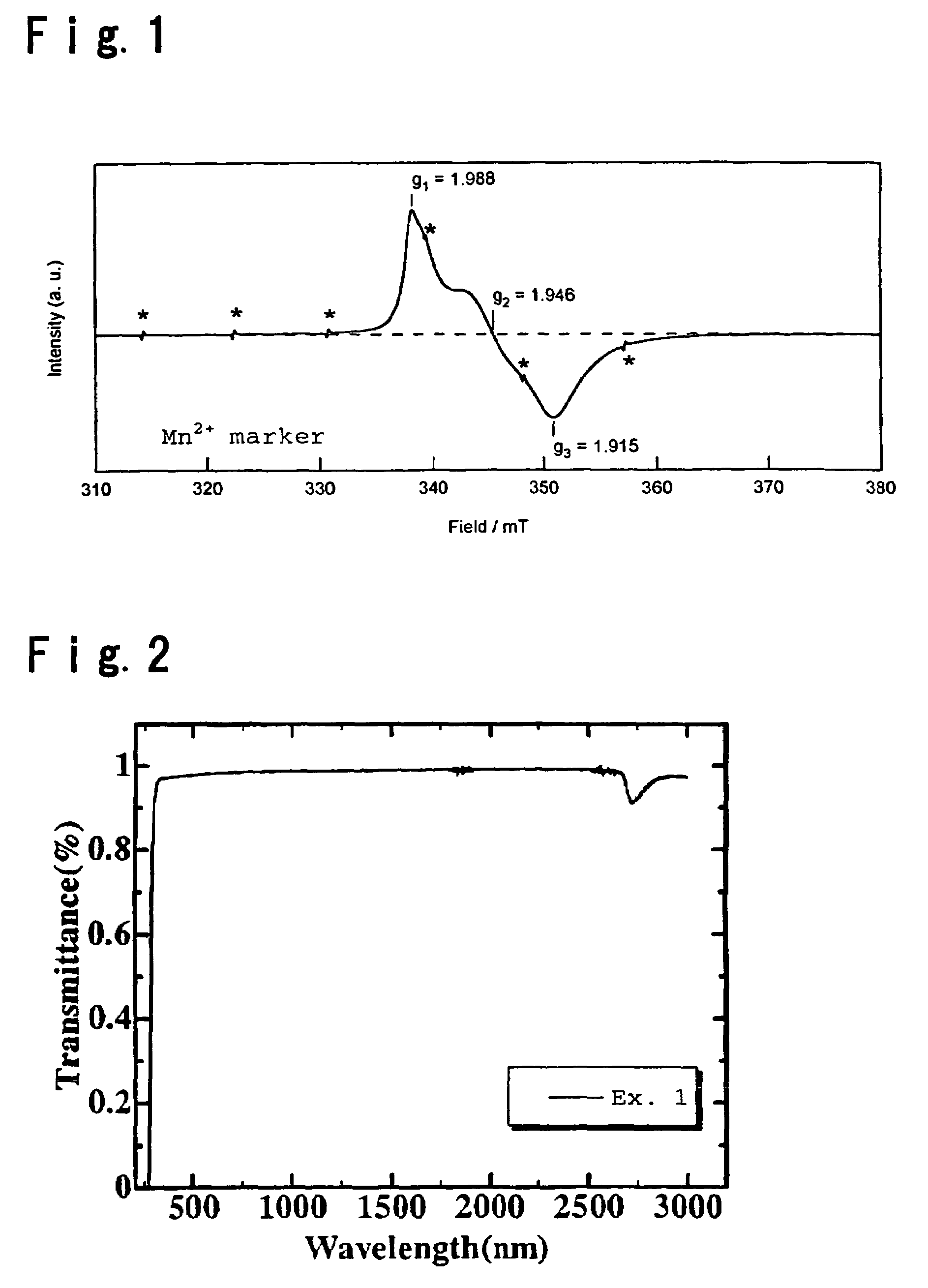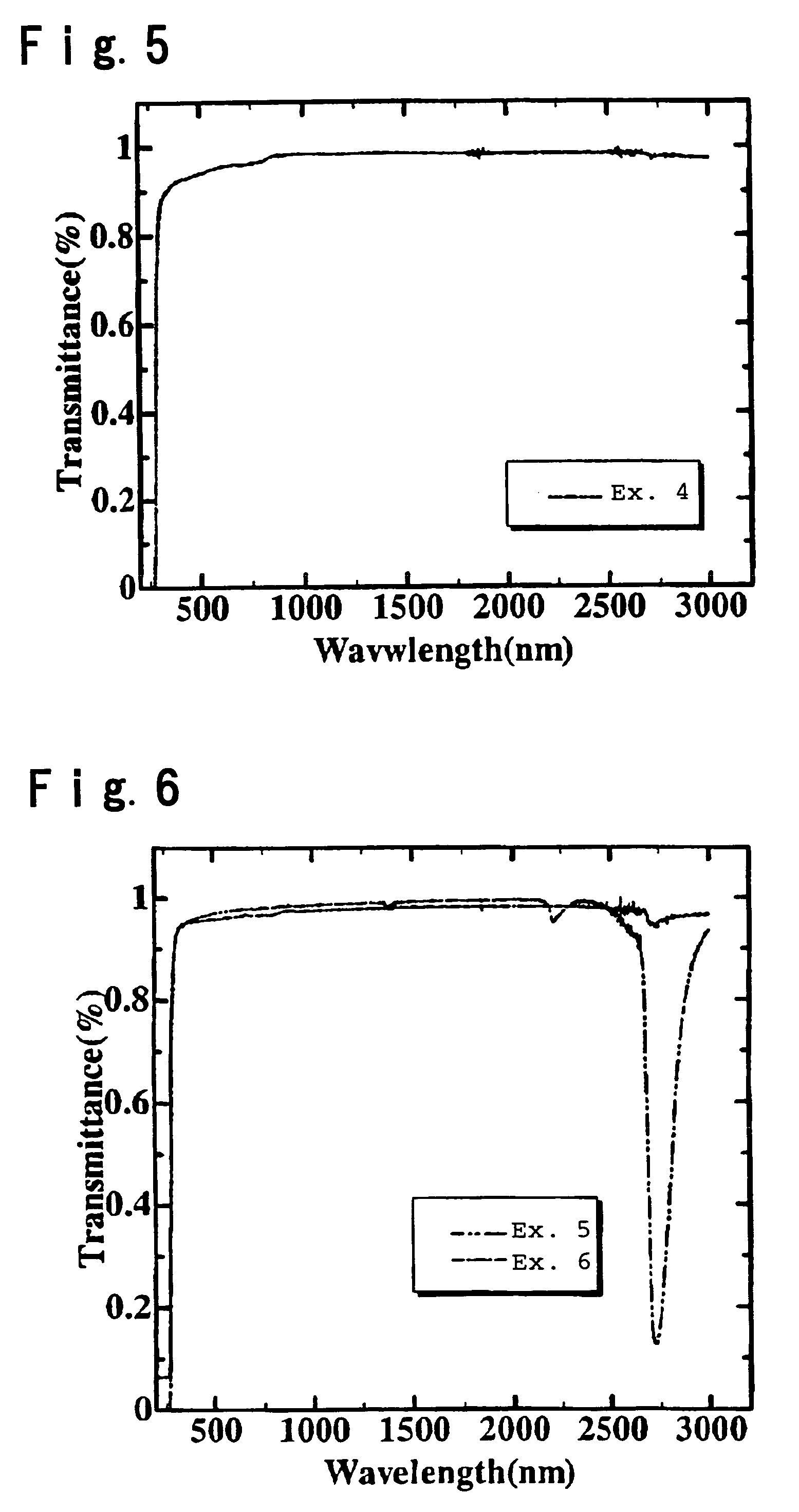Silica glass containing TiO2 and process for its production
a technology of silicon glass and tio2 is applied in the field of silicon glass containing tio2, which can solve the problems of hysteria of the change in dimension along with the change in temperature, the temperature range where the coefficient of thermal expansion is substantially zero, and the inability to meet the requirements of the application of glass making apparatus, etc., to achieve excellent transparency, low thermal expansion properties and transparency.
- Summary
- Abstract
- Description
- Claims
- Application Information
AI Technical Summary
Benefits of technology
Problems solved by technology
Method used
Image
Examples
example 1
[0083]TiO2—SiO2 glass particles obtained by gasifying TiCl4 and SiCl4 as glass-forming materials for TiO2—SiO2 glass, respectively, then mixing them and feeding them to heat hydrolysis (flame hydrolysis) in oxyhydrogen flame, were deposited and grown on a target to form a porous TiO2—SiO2 glass body having a diameter of about 80 mm and a length of about 100 mm (porous glass body formation step).
[0084]The obtained porous TiO2—SiO2 glass body was difficult to handle as it was, and as deposited on the target, it was maintained at 1,200° C. for 4 hours in atmospheric air and then removed from the target.
[0085]Thereafter, it was held in an atmosphere of 100% He at 1,450° C. for 4 hours to obtain a TiO2—SiO2 dense body (densification step).
[0086]The obtained TiO2—SiO2 dense body was held at 1,650° C. for 4 hours to obtain a high transmittance glass body (vitrification step).
[0087]The obtained high transmittance glass body was put in a carbon mold, heated at 1,650° C. and formed into a blo...
example 2
[0089]TiO2—SiO2 glass particles obtained by gasifying TiCl4 and SiCl4 as glass-forming materials for TiO2—SiO2 glass, respectively, then mixing them and feeding them to heat hydrolysis (flame hydrolysis) in oxyhydrogen flame, were deposited and grown on a target to form a porous TiO2—SiO2 glass body having a diameter of about 250 mm and a length of about 1,000 mm (porous glass body formation step).
[0090]The obtained porous TiO2—SiO2 glass body was difficult to handle as it was, and as deposited on the target, it was maintained at 1,200° C. for 4 hours in atmospheric air and then removed from the target.
[0091]Thereafter, the porous TiO2—SiO2 glass body was held at 1,450° C. for 4 hours under reduced pressure to obtain a TiO2—SiO2 dense body (densification step).
[0092]The obtained TiO2—SiO2 dense body was put in a carbon mold and held at 1,700° C. for 10 hours to obtain a formed glass body having a high transmittance (forming step). In this forming step, vitrification is simultaneousl...
example 3
[0094]TiO2—SiO2 glass particles obtained by gasifying TiCl4 and SiCl4 as glass-forming materials for TiO2—SiO2 glass, respectively, then mixing them and feeding them to heat hydrolysis (flame hydrolysis) in oxyhydrogen flame, were deposited and grown on a target to form a porous TiO2—SiO2 glass body having a diameter of about 80 mm and a length of about 100 mm (porous glass body formation step).
[0095]The obtained porous TiO2—SiO2 glass body was difficult to handle as it was, and as deposited on the target, it was maintained at 1,200° C. for 4 hours in atmospheric air and then removed from the target.
[0096]Thereafter, the porous TiO2—SiO2 glass body was set in a chamber capable of controlling the atmosphere, and after reducing the pressure to 10 Torr (1,333 Pa) at room temperature, a gas mixture of O2 / SiF4=90 / 10 (volume ratio) was introduced, and the glass body was held at room temperature under atmospheric pressure for 24 hours to carry out F-doping (F-doping step).
[0097]Further, th...
PUM
| Property | Measurement | Unit |
|---|---|---|
| internal transmittance | aaaaa | aaaaa |
| thickness | aaaaa | aaaaa |
| fictive temperature | aaaaa | aaaaa |
Abstract
Description
Claims
Application Information
 Login to View More
Login to View More - R&D
- Intellectual Property
- Life Sciences
- Materials
- Tech Scout
- Unparalleled Data Quality
- Higher Quality Content
- 60% Fewer Hallucinations
Browse by: Latest US Patents, China's latest patents, Technical Efficacy Thesaurus, Application Domain, Technology Topic, Popular Technical Reports.
© 2025 PatSnap. All rights reserved.Legal|Privacy policy|Modern Slavery Act Transparency Statement|Sitemap|About US| Contact US: help@patsnap.com



